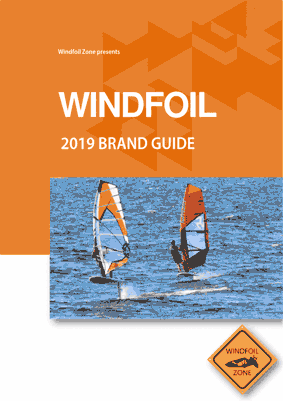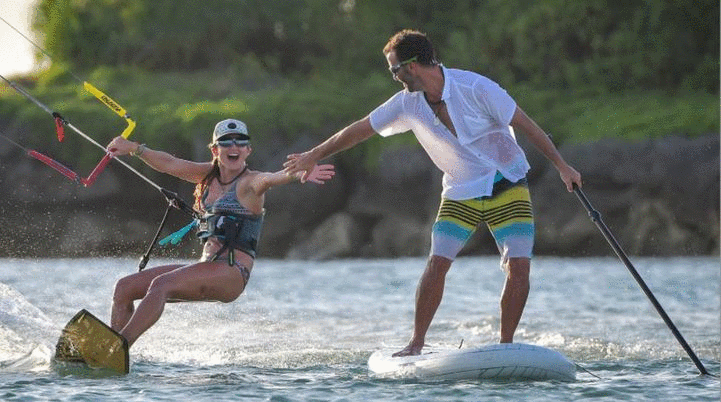Windfoil Speed: How fast can you fly on a windsurf foil?
- Romain
- Jun 17, 2019
- 7 min read
Updated: May 30, 2020
Windsurfing has always been about speed. However, we realise that a limit may have been reached when it comes to how fast a windsurfer can sail. We may gain some more knots by improving the drag of the board and the sail, making it more hydrodynamic.
But in order to significantly improve Antoine Albeau’s record of 55 knots, we will need much more wind and much bigger sail. This is of course a big challenge to hold an 8.0 m in 70 knots of wind...
Can the solution come from hydrofoils?
That’s of course what everybody hopes. However, an assumption would be that a hydrofoil helps to get planning earlier and higher speeds in light wind, but that the drag of the foil in the water may limit the top speed. To get more clarity on this question, we have asked some questions to both a specialist and a bunch of foiling experts.
CURRENT WORLD RECORD : 36,44 KNOTS (VMAX) BY NICOLAS GOYARD
(January 2020)
THE SPECIALIST: Rajko Zuzek is specialised in composite materials and head of R&D of Bug Fins & Foils:
WZ: Hydrofoil drag increases with speed. What more can you say about this assumption?

There are 2 different types of drag with a foil: “Induced drag” (drag due to lift) decreases with speed, while “profile drag” (basically the drag due to water friction) increases with speed. At high foiling speeds, profile drag dominates and increases with the square of speed.
Of course, foil’s max speed is limited and not every rider will be able to get there. For all others, it is important that we can fly with a comfortable speed, which is allowing a self-alignment of the foil’s angle of attack.
For an efficient take-off, a certain angle of attack (aka AOA) is needed, but once in the air with a certain speed, the foil will execute the alignment (board nose down) in order to fly with zero AOA. This way, drag is optimized and flight is comfortable.
WZ: That’s bad news. It sounds like hydrofoils will never be able to achieve high speeds… Are there other factors influencing the drag of the hydrofoil, which may be improved?
RZ: Each foil component (mast, wings, and fuselage) should be shaped with hydrodynamic efficiency in mind. The wings’ surface and profile shape are designed to create needed thrust (lift), in accordance with the fuselage length. There are many factors that can be modified in order to create a balanced and efficient foil.
For example, it’s possible to play with the stabiliser’s shape and it’s angle of attack. The stabiliser’s job is to create the needed down force to stabilise the whole. There are two possible approaches: Symmetrical stabs and asymmetrical stabs

Symmetrical stabilisers are creating down force simply with their angle of attack. Higher angle = higher downward force – but higher drag as well (lower speed). Working with asymmetrical stabilisers is a better way, as they generate down force with zero AOA and the needed down force is created with minimal drag. The result is higher speed due to less drag.

The hydrodynamic (surface friction) of the foil is another factor contributing to increased speed: A smooth varnished finish helps reduce profile drag so can improve top speed. But as always, here are many details…

I have a wide experience with surface preparation from my carbon fins:
- We use shiny foil wings for low wind setups. The surface is super smooth and buffed to shine.
- For higher speeds, wings can still be shiny, but the surface is brushed with lower grit sanding paper. This may be counterintuitive, but it creates micro cavities where water molecules are trapped, forming a buffer between the wings and flowing water which reduces the drag. The result is minimized surface friction and higher speed.
(Picture: Bug's freeride windfoil with shiny finish)
WZ: In your opinion, what can be done to improve current hydrofoil shape, to increase the speed?
RZ: We are working on and testing new features all the time, and we will definitely come up with some innovations in the future, so stay tuned! But in general, hydrofoil performance can be pushed with sharp trailing edges on wings and masts.
Rigidity is also a key factor. Only rigid – stiff and torsional resistant foil will perform well, otherwise you cannot speed it up without having perfect control.
THE EXPERTS: What is your personal speed record and how do you see top speed in the future?
Benjamin Tillier:
My top speed is 31.6 knots, but I prefer to talk about V500, which is more representative of the potential of windfoiling: I do 28.2 knots on average in 20 knots of wind.
In the near future, many will reach 30 knots, even on V500 and probably in even less wind than 20 knots, which shows the great potential of windfoiling!
Already today we have some incredible top speeds in only 8-10 knots of wind.
The normal evolution of windfoils will follow the kitefoils which are incredibly performant today. The foils will need to be even stiffer. Titanium will be introduced and will improve the quality of the fuselage for example. The wings profiles will continue to evolve and will be more stiff, stable and powerful.
Benjamin Tillier showing his windfoil skills
When it comes to sails, there is a lot of improvement to do to gain in lightness and stability. The same evolution happened in kitefoiling with the introduction of open cell foil kites.
Boards will also evolve in different directions as in regular windsurfing, optimised for racing, speed or freestyle.
Let’s not forget that the protective gear of the windfoilers will also evolve as we are reaching a higher speed: helmets, impact vests, and impact wetsuits.
To summarize, we are only at the beginning!
Read also our popular blog post:

Antoine Albeau: F-192
Sponsors: NP, JP, MAN, Quiksilver, Sosh, Chris Benz, Charente Maritime, Ile de Ré, Campings Charente Maritime, MMA Mader.
website: www.antoinealbeau.com
I think my top speed is 31 knots, but I don’t remember exactly!
In the future, I hope that we can soon reach 50 knots or more, but the foils will probably be different from the ones we use today.
Nicolas Goyard - F465 (fastest foiler on the planet!)
Sponsors: Tabou, Gaastra, Phantom
Instagram: @Nico.f465
My speed record is 36.44 knots in top speed (Vmax) and 33.2 knots on V500 (WZ: average speed on 500 meters, which is the reference for speed windsurfing). I have not heard about anybody going faster than that but I may be wrong! Maybe Sebastian (Kornum) is going faster?

I think we will go even faster in the future. I think the limit could be 36-38 knots, but we may go even faster!
It will also be interesting to see if we can increase the average speed by 2-3 knots because then the regular slalom boards will have problems following us!
Sebastian Kornum - DEN 24
Sponsors: JP-Australia - NeilPryde
Instagram: @sebastiankornum
I usually don't use GPS so I am not really aware of my top speed at all. Hopefully more than 30 knots, but I can't prove it!
Sebastian Kornum: More than 30 knots run?
Fred Morin - NC5
Sponsors: Quiksilver
Instagram: @fredmorin_nc5
My top speed in windfoiling is 28.2 knots.
I think the windfoil equipment will continue to evolve and that speed will increase rapidly. Some top riders are already at 32-33 knots while it was completely unbelievable just a few months ago. So I think windfoiling has not finished surprising us!
Fred Morin cruising in Moorea

Sam Ross
Windfoil coach at Sam Ross water sport school
I don’t always record it but just taking a quick look, I’m at about 27 knots at the moment.
I think there is no reason why we won’t see people break 40 knots in the next year or so. And after that, who knows?
Julien Bontemps
World champion and Olympic medalist. Sponsored by Neilpryde and JP.
Facebook: Julien Bontemps
I’m at a little bit more than 31 knots in Vmax.I think it will be possible to go much faster, it’s only the beginning. The brand’s R&D is more focus on offering light wind foils at the moment and those hydrofoils are not the fastest ones.
But this can change quickly, and some may focus on top speed instead in the future.

Julien Bontemps - Photo: Eric Bellande
Philippe Caneri – Horue:
My top speed is 27 knots, but I’m not particularly good in speed surfing and have never trained slalom windsurfing.

William Huppert - FRA 330
Instagram: @william_huppert
I have 33.15 knots in top speed with the Lokefoil LK1 wing 600.
The top speed is increasing all the time, so I think we will reach 40 knots within a few years. To do so, foils will need to have even better profiles, stability, and the riders need to progress as well!
William Huppert and his 33 knots run

Renaud Barbier – Mantafoils
My top speeds are 26kts with the Mantafoil mono alu and 28kts with the carbon foil, but other riders should be able to reach 32-34kts with this foil.
Gonzalo Costa Hoevel - ARG3
sponsors: Starboard, Severne, Chopper fins
Instagram: @gonzalocostahoevel
My highest speed is 30.5 knots, and I think that pretty soon we will be able to hit 35 knots.
Key take outs from these interviews with experts:
We are only at the beginning of windfoiling. Equipment will evolve in the near future, and 40 knots in the near future is within reach.
World speed record (top speed) in windfoiling in March 2019: 35,10 knots by Nicolas Goyard. This is of course unofficial measurements, but it gives the right idea of where we are at the moment.
Let us know if you know anyone with a better top speed!










Comments